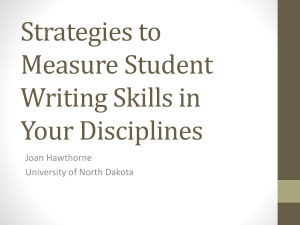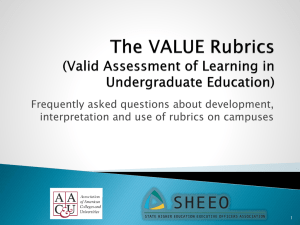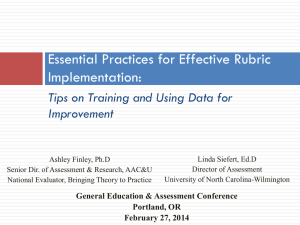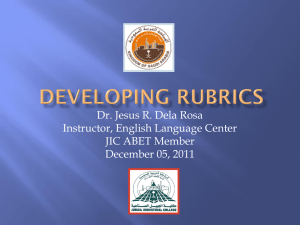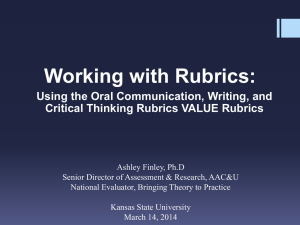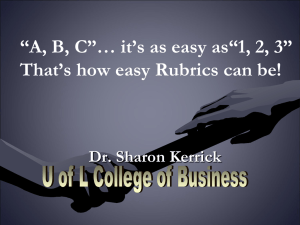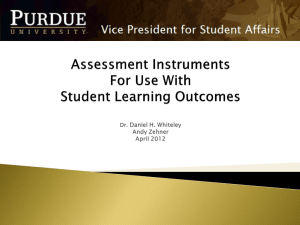Direct Assessment in Student Affairs
advertisement
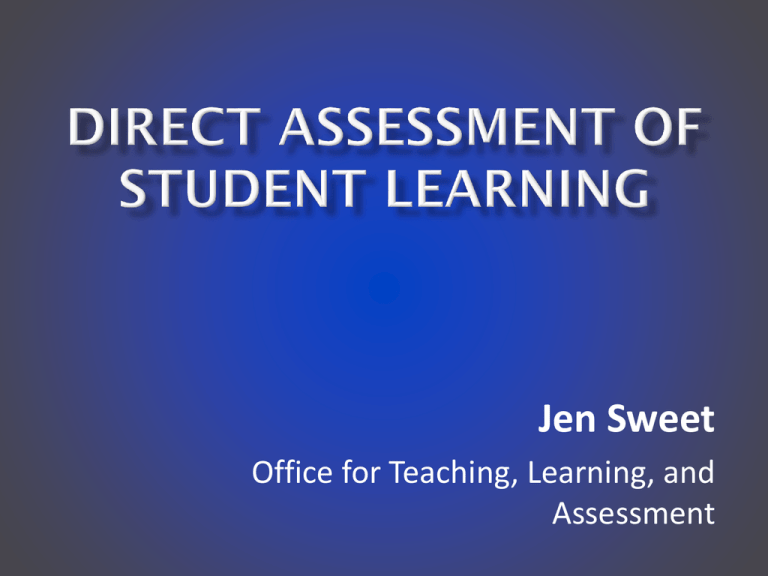
Jen Sweet Office for Teaching, Learning, and Assessment Participants will know how to: Differentiate between Indirect and Direct Assessment Identify and Apply Direct Assessment Methods Write Effective Prompts Develop Scoring Guides and Rubrics Direct evidence of student learning is tangible, visible, self-explanatory, and compelling evidence of exactly what students have and have not learned. Indirect evidence consists of proxy signs that students are probably learning. Indirect evidence is less clear and less convincing. Who decides what was learned and/or how well it was learned? Does the assessment measure the learning or is it a proxy for learning? General Rule: In Direct Assessment, a professional makes a decision regarding what was learned and how well it was learned. -ex. faculty or staff evaluated reflection paper In Indirect Assessment, the student decides what was learned and how well it was learned. - ex. surveys, teaching evaluations Direct Evidence: Students have completed some work or product that demonstrates they have achieved the learning outcome - ex. project Indirect Evidence: A proxy measure was used, such as participation in a learning activity, students’ opinions about what was learned, student satisfaction, etc. - ex. number of students who visited an office or office hours DIRECT Professional ratings of student skills Written work, performances, presentations Portfolios Observation of behavior Professional ratings of student reflections INDIRECT Student self ratings of their knowledge and skills and what they have learned over the course of a program Student satisfaction with learning Student perceptions (ex. teaching evaluations) Retention and graduation rates Out of the Classroom: Limited or Inconsistent Exposure to Students Motivation to Participate in the Assessment In the Classroom: Motivation to Participate in the Assessment Captive Audience! Embed Assessment into your Student Contact Activities Bring the Students into the Process - - Explain what you are doing and why you are doing it Inform students of what will be done with the results of the assessment - - Potentially, offer to make results available to students Think about giving students an opportunity to provide feedback on the assessment Make sure it “counts,” even just a little A prompt is simply a task: a statement or question that tells students what they should do (ex. in a survey item, essay question, or performance). Prompts should “prompt” students to demonstrate the learning outcome that is being assessed. Suskie, L. (2009). Assessing student learning: A common sense guide. Jossey-Bass: San Francisco, CA Restricted Response prompts limit the way in which students may present information. Advantage: Easier to evaluate Disadvantage: Restricts students ability to provide diverse, individualized responses that provide richer information Extended Response prompts give students more latitude in deciding how to respond, including the format, length, and construction of the response. Advantage: Provides richer information by allowing for diversity in responses. Disadvantage: Requires more time to evaluate responses. Suskie, L. (2009). Assessing student learning: A common sense guide. Jossey-Bass: San Francisco, CA Good prompts are a critical part of teaching and learning process Communicate expectations Inspires students to do their best and achieve learning outcomes “With a poorly written response, students may complete the assignment without learning what we want them to learn.” Suskie, L. (2009). Assessing student learning: A common sense guide. Jossey-Bass: San Francisco, CA Decide what you want students to learn from the experience. Determine how the learning aligns with your learning outcomes. Develop a meaningful task or problem related to identified learning outcome(s). Determine the methods you will use to measure (scoring guide, rubric, reflection, etc.) students’ learning. You are on the subway and overhear a conversation about . . . You are a corporate trainer leading a diversity workshop . . . You are a consultant working with a community organization . . . You are a business executive leading a high stakes meeting . . . Program Learning Outcome: Students will be able to identify options for postgraduate study/work and understand the implications for each. Prompt: Please consider the options you’ve learned about to continue your education after you receive your bachelor’s degree. Select one you think might be a good fit for you and briefly discuss: Master’s Degree Joint Master’s/PhD program Professional School Trade School Work with 1 or 2 people around you – do you see any problems with this prompt? If so, can you recommend a better prompt? A Few Problems: First part of the outcome is not directly addressed because options have been given Data from this prompt indicated students did not understand the implications for post-graduate study options because, by in large, students did not identify any implications. Follow-up with a focus group, however, revealed the students actually did have good knowledge of the implications and were able to discuss them in meaningful ways. Better Prompt? Throughout this program, we’ve discussed different options for continuing your education after you complete your bachelor’s degree. Select two or three you feel might be a good fit for you and discuss the implications of each option based on your future goals and aspirations. As the name implies, scoring guides generally provide a structure and definition of how student performance will be judged. A Scoring guide should be tied directly to the student learning outcome it is measuring. Examples of Common Scoring Guides: Rubrics Structured Observation Guides Criteria for Evaluation of Students’ Performances Defined Levels of Performance generally associated with a numeric value (ex. 1-4) Description of each Level detailed information regarding the qualities that should be or should not be present in a product/performance to receive a rating at each level Airasian, P.W. and Russell, M.K. (2008). Classroom assessment: Concepts and applications (6th ed.). New York: McGraw Hill. Identifying important aspects (elements, behaviors, components, qualities, features, characteristics) of a performance or product to be assessed. Questions to consider: What do I want my students to learn from carrying out this process or producing this product? What would a high quality product look like? What are its essential, defining characteristics or features? What does the student need to do to complete the performance task or produce the product that I have in mind? What are the specific steps the student will need to follow to complete a task? Deciding on a range of score points for each of the important aspects. Questions to consider: What is the minimum number of performance levels I need to adequately describe the range of performance I am seeing in student work? The range of score points can be binary (e.g., Achieved/Did Not Achieve, Met/Not Met) or more than two categories (e.g., Exceeded/Met/Did Not Meet). A common number of categories is between 3 and 7. However, the choice of number of score points should not be arbitrary. Myford, C. (Spring 2006). Performance assessment, PowerPoint presentation 1. Holistic Rubrics 2. Analytic Trait Rubrics Developmental Rubrics Arter, J. & McTighe, J. (2001). Scoring rubrics in the classroom (T.R. Guskey & R.J. Marzano, Eds.). Thousand Oaks, CA: Corwin Press. A holistic rubric gives one score for an entire work or product. The rubric combines all important components of the student’s performance to arrive at a single judgment of the quality of the final product. Advantages Emphasis on what the learner is able to demonstrate, rather than what s/he cannot do. Saves time by minimizing the number of decisions raters make. Can be applied consistently by trained raters increasing reliability. Disadvantages Does not provide specific feedback for improvement. When student work is at varying levels spanning the criteria points it can be difficult to select the single best description. Criteria cannot be weighted. Arter, J. and McTighe, J. (2001). Scoring rubrics in the classroom (T.R. Guskey & R.J. Marzano, Eds.). Thousand Oaks, CA: Corwin Press. Office for Teaching, Learning, & Assessment (n.d.). Types of rubrics. DePaul University Office for Teaching Learning and Assessment. Retrieved February 13, 2013, from http://condor.depaul.edu/tla/Assessment/TypesRubrics.html Articulating thoughts through written communication— final paper/project. Above Average (4): The audience is able to easily identify the focus of the work and is engaged by its clear focus and relevant details. Information is presented logically and naturally. There are no more than two mechanical errors or misspelled words to distract the reader. Sufficient (3): The audience is easily able to identify the focus of the student work which is supported by relevant ideas and supporting details. Information is presented in a logical manner that is easily followed. There is minimal interruption to the work due to misspellings and/or mechanical errors. Developing (2): The audience can identify the central purpose of the student work with little difficulty and supporting ideas are present and clear. The information is presented in an orderly fashion that can be followed with little difficulty. There are some misspellings and/or mechanical errors, but they do not seriously distract from the work. Needs Improvement (1): The audience cannot clearly or easily identify the central ideas or purpose of the student work. Information is presented in a disorganized fashion causing the audience to have difficulty following the author’s ideas. There are many misspellings and/or mechanical errors that negatively affect the audience’s ability to read the work. Office for Teaching, Learning, & Assessment (n.d.). Types of rubrics. DePaul University Office for Teaching Learning and Assessment. Retrieved February 13, 2013, from http://condor.depaul.edu/tla/Assessment/TypesRubrics.html An Analytic Trait Rubric divides the product or performance into important components or traits, then evaluates each one separately. Advantages Can provide useful feedback on areas of strength and weakness. Criterion can be weighted to reflect the relative importance of each dimension. Can give specific feedback on each important dimension. Disadvantages Takes more time to create and use than a holistic rubric. Unless each point for each criterion is well-defined raters may not arrive at the same score. Arter, J. and McTighe, J. (2001). Scoring rubrics in the classroom (T.R. Guskey & R.J. Marzano, Eds.). Thousand Oaks, CA: Corwin Press. Office for Teaching, Learning, & Assessment (n.d.). Types of rubrics. DePaul University Office for Teaching Learning and Assessment. Retrieved February 13, 2013, from http://condor.depaul.edu/tla/Assessment/TypesRubrics.html Articulating thoughts through written communication— final paper/project. Dimension Needs Improvement (1) Developing (2) Sufficient (3) Above Average (4) Clarity (Thesis supported by relevant information and ideas.) The purpose of the student work is not well-defined. Central ideas are not focused to support the thesis. Thoughts appear disconnected. The central purpose of the student work is identified. Ideas are generally focused in a way that supports the thesis. The central purpose of the student work is clear and ideas are almost always focused in a way that supports the thesis. Relevant details illustrate the author’s ideas. The central purpose of the student work is clear and supporting ideas always are always well-focused. Details are relevant, enrich the work Organization (Sequencing of Elements/Ideas) Information and ideas are poorly sequenced (the author jumps around). The audience has difficulty following the thread of thought. Information and ideas are presented in an order that the audience can follow with minimum difficulty. Information and ideas are presented in a logical sequence which is followed by the reader with little or no difficulty. Information and ideas are presented in a logical sequence which flows naturally and is engaging to the audience. Mechanics (Correctness of grammar and spelling) There are five or more misspellings and/or systematic grammatical errors per page or 8 or more in the entire document. The readability of the work is seriously hampered by errors. There are no more than four misspellings and/or systematic grammatical errors per page or six or more in the entire document. Errors distract from the work. There are no more than three misspellings and/or grammatical errors per page and no more than five in the entire document. The readability of the work is minimally interrupted by errors. There are no more than two misspelled words or grammatical errors in the document. Office for Teaching, Learning, & Assessment (n.d.). Types of rubrics. DePaul University Office for Teaching Learning and Assessment. Retrieved February 13, 2013, from http://condor.depaul.edu/tla/Assessment/TypesRubrics.html A type of analytic trait rubric Not evaluating an end product or performance, but interested in answering the question, “to what extent are students who engage in our programs/services developing this skill/ability/value/etc.?” Generally, this type of rubric would be based on a theory of development. Advantages Useful when the goal of evaluation is to determine level of development rather than the quality of a final product. Rubric can be based on relevant developmental theory Disadvantages Conceptually, more difficult to design. Requires close tie between assessment criteria and theory of development. Intercultural Maturity Domain Initial Level of Development (1) Intermediate Level of Development (2) Mature Level of Development (3) Cognitive Assumes knowledge is certain and categorizes knowledge claims as right or wrong; is naïve about different cultural practices and values; resists challenges to one’s own beliefs and views differing cultural perspectives as wrong Evolving awareness and acceptance of uncertainty and multiple perspectives; ability to shift from accepting authority’s knowledge claims to personal processes for adopting knowledge claims Ability to consciously shift perspectives and behaviors into an alternative cultural worldview and to use multiple cultural frames Intrapersonal Lack of awareness of one’s own values and intersection of social (racial, class, ethnicity, sexual orientation) identity; lack of understanding of other cultures; externally defined identity yields externally defined beliefs that regulate interpretation of experiences and guide choices; difference is viewed as a threat to identity Evolving sense of identity as distinct from external others’ perceptions; tension between external and internal definitions prompts self-exploration of values, racial identity, beliefs; immersion in own culture; recognizes legitimacy of other cultures Capacity to create an internal self that openly engages challenges to one’s views and beliefs and that considers social identities (race, class, gender, etc.) in a global and national context; integrates aspects of self into one’s identity Interpersonal Dependent relations with similar others is a primary source of identity and social affirmation; perspectives of different others are viewed as wrong; awareness of how social systems affect group norms and intergroup differences is lacking; view social problems egocentrically, no recognition of society as an organized entity Willingness to interact with diverse others and refrain from judgment; relies on independent relations in which multiple perspectives exist (but are not coordinated); self is often overshadowed by need for others’ approval. Begins to explore how social systems affect group norms and intergroup relations Capacity to engage in meaningful, interdependent relationships with diverse others that are grounded in an understanding and appreciation for human differences; understanding of ways individual and community practices affect social systems; willing to work for the rights of others King, P. M. & Baxter Magolda, M. B. (2005). A developmental model of intercultural maturity. Journal of College Student Development, 46(2), 571-592. Scenario presented for a peer training program related to diversity: Marieka walks into a study lounge to get some work done between classes and sits at an empty table. She overhears the following conversation between two students she knows from class. Ed: “I can’t believe my brother didn’t get into Northwestern University – he had a 3.4 GPA in high school! You know that if he was black, he would have gotten in!” Tiffany: “Yeah, they have all these programs to help ‘minorities,’ but if you’re white, no one cares. A lot of those kids who get special treatment because their great, great, great, great, greeeaaatt grandpas were slaves are richer and went to better schools than we did. Slavery happened a long time ago – why are they still benefitting from it?” Ed: “Worse than being white these days is being a white man. It’s nothing more than reverse discrimination!” 1. 2. To what extent do you agree or disagree with Ed and Tiffany’s conversation? If you were Marieka, how would you react? A more qualitative type of scoring guide. Advantages May allow for a richer description of student performance or work. May be useful for assessment of qualities that are difficult to operationally define, like attitudes or values Disadvantages This is a more subjective approach to scoring. May be more difficult to align with learning outcomes. More difficult to analyze results. Suskie, L. (2009). Assessing student learning: A common sense guide. Jossey-Bass: San Francisco, CA. Structured Observation Guide for a Presentation Effectiveness of Presenter in: Notes Communicating the Purpose of the Presentation Organizing the Presentation Demonstrating Good Knowledge of the Topic(s) Speaking with Clarity Responding Appropriately to Participants’ Questions Adhering to Time Constraints Accomplishing the Stated Objective Adapted from: Suskie, L. (2009). Assessing student learning: A common sense guide. Jossey-Bass: San Francisco, CA. • • • • • Airasian, P.W. and Russell, M.K. (2008). Classroom assessment: Concepts and applications (6th ed.). New York: McGraw Hill. Arter, J. and McTighe, J. (2001). Scoring rubrics in the classroom (T.R. Guskey & R.J. Marzano, Eds.). Thousand Oaks, CA: Corwin Press. Myford, C. (Spring 2006). Performance assessment, PowerPoint presentation. Office for Teaching, Learning, & Assessment (n.d.). Types of rubrics. DePaul University Office for Teaching Learning and Assessment. Retrieved February 13, 2013, from http://condor.depaul.edu/tla/Assessment/TypesRubrics.html Suskie, L. (2009). Assessing student learning: A common sense guide. San Francisco, CA: Jossey-Bass.

